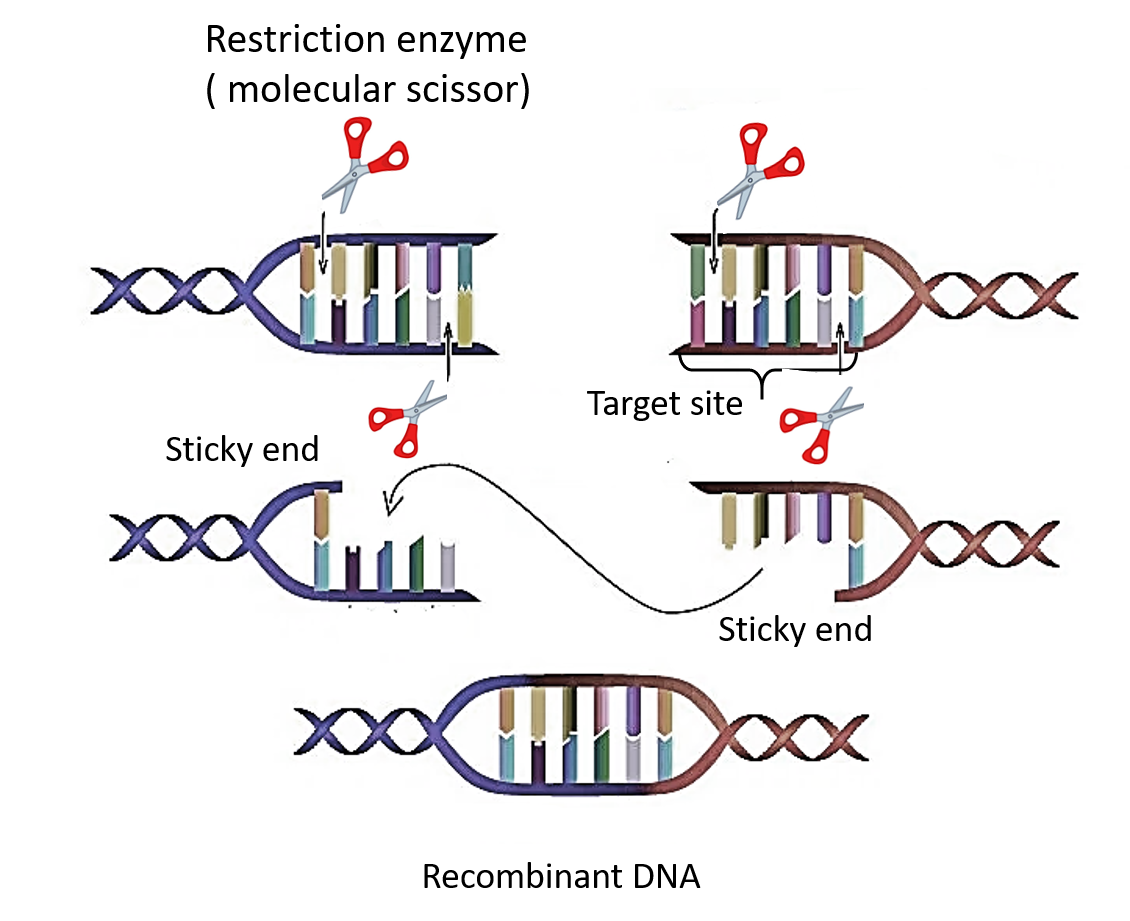
What are palindromic nucleotide sequences?
Answer
465k+ views
Hint: Palindromic nucleotide sequences are that sequences in the DNA that can be recognized by restriction endonucleases. Each restriction endonuclease enzyme has a unique and specific palindromic nucleotide sequence which is then cut by the enzyme to produce blunt or sticky ends.
Complete answer:
Palindromic words are words that remain the same when read from the forward direction or from the backward direction. For example, the words MALAYALAM, NOON, LEVEL read the same whether we read it from the backward or forward direction. Palindromic nucleotide sequences are the nitrogen base pair sequence in DNA which remains the same whether it is read in $5'\xrightarrow { } 3'$ direction or $3'\xrightarrow { } 5'$ direction. Such sequences are recognized by restriction endonuclease when they inspect the length of a DNA sequence. Once the enzyme finds its sequence, the enzyme binds to the DNA and cuts each of the strands of DNA at specific points. An example of a palindromic sequence is
5’ --- GAATTC --- 3’
3’ --- CTTAAG --- 5’
Additional Information:
-Nucleases are enzymes that act on nucleic acids like DNA and RNA to digest them. They are further divided into exonucleases and endonucleases.
-Exonucleases are enzymes that remove nucleotides from the ends of the DNA whereas endonucleases make cuts inside the DNA.
-Endonucleases do not cut the DNA at random positions but instead search for a specific palindromic sequence and cut it.
-When an endonuclease cuts the palindromic sequence a little away from the center, it results in single-stranded portions at the ends. These overhanging stretches of bases are known as sticky ends.
-When an endonuclease cuts the palindromic sequence at the center, there are no overhanging stretches of nucleotides at the ends known as blunt ends.
Note: -Restriction enzymes are used to make recombinant DNA which is composed of DNA from two different DNA genomes.
-Restriction enzymes cut the same sequence in both the DNA thus resulting in the same edges to be formed which are then joined together by DNA ligase.
-The first restriction endonuclease was Hind-II which was isolated from the bacteria Haemophilus influenzae.

Complete answer:
Palindromic words are words that remain the same when read from the forward direction or from the backward direction. For example, the words MALAYALAM, NOON, LEVEL read the same whether we read it from the backward or forward direction. Palindromic nucleotide sequences are the nitrogen base pair sequence in DNA which remains the same whether it is read in $5'\xrightarrow { } 3'$ direction or $3'\xrightarrow { } 5'$ direction. Such sequences are recognized by restriction endonuclease when they inspect the length of a DNA sequence. Once the enzyme finds its sequence, the enzyme binds to the DNA and cuts each of the strands of DNA at specific points. An example of a palindromic sequence is
5’ --- GAATTC --- 3’
3’ --- CTTAAG --- 5’
Additional Information:
-Nucleases are enzymes that act on nucleic acids like DNA and RNA to digest them. They are further divided into exonucleases and endonucleases.
-Exonucleases are enzymes that remove nucleotides from the ends of the DNA whereas endonucleases make cuts inside the DNA.
-Endonucleases do not cut the DNA at random positions but instead search for a specific palindromic sequence and cut it.
-When an endonuclease cuts the palindromic sequence a little away from the center, it results in single-stranded portions at the ends. These overhanging stretches of bases are known as sticky ends.
-When an endonuclease cuts the palindromic sequence at the center, there are no overhanging stretches of nucleotides at the ends known as blunt ends.
Note: -Restriction enzymes are used to make recombinant DNA which is composed of DNA from two different DNA genomes.
-Restriction enzymes cut the same sequence in both the DNA thus resulting in the same edges to be formed which are then joined together by DNA ligase.
-The first restriction endonuclease was Hind-II which was isolated from the bacteria Haemophilus influenzae.

Recently Updated Pages
The correct geometry and hybridization for XeF4 are class 11 chemistry CBSE

Water softening by Clarks process uses ACalcium bicarbonate class 11 chemistry CBSE

With reference to graphite and diamond which of the class 11 chemistry CBSE

A certain household has consumed 250 units of energy class 11 physics CBSE

The lightest metal known is A beryllium B lithium C class 11 chemistry CBSE

What is the formula mass of the iodine molecule class 11 chemistry CBSE

Trending doubts
State the laws of reflection of light

Arrange Water ethanol and phenol in increasing order class 11 chemistry CBSE

One Metric ton is equal to kg A 10000 B 1000 C 100 class 11 physics CBSE

Difference Between Prokaryotic Cells and Eukaryotic Cells

A mixture of o nitrophenol and p nitrophenol can be class 11 chemistry CBSE

How do I convert ms to kmh Give an example class 11 physics CBSE




